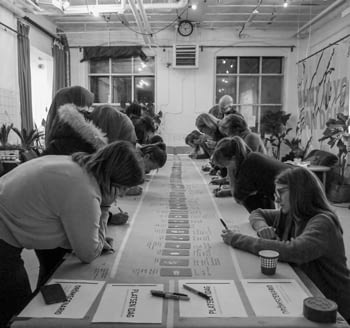Authors: Elin Andersdotter Fabre and Tove Derner
(4 min read)
The starting point for Urban Girls Movement (UGM) is the notion of ‘plan a city for girls, and it will work for everyone’. The hypothesis has successfully tested in the Stockholm suburb Botkyrka and contributes to advancing the practice of feminist urban planning.
The UGM approach is developed to fit any public space regeneration project but particularly meets the needs of deprived neighbourhoods, focusing on health and well-being, gender equality and reducing inequalities through multi-stakeholder participation and partnerships in the public spaces of a local community.
Highlighting young women’s experiences and needs early in an urban planning phase, such as girls’ integration, education and work opportunities significantly enhances inclusion, health and well-being of all citizens in the area. A successful participation process is one that responds to the actual needs of the population living in and around the area. Involving marginalised actors and other relevant stakeholders early on adds legitimacy and quality to the process and outcomes. It also shows that such a process is not difficult to achieve, but rather facilitates implementation and keeps costs down as the right priorities are made. However, process owners need to believe in a true multi-stakeholder approach, bringing all actors to the table equally and in the earliest stage.
Based on a global mapping of good participatory practices, UGM has developed a method and a toolbox for gender- and age-sensitive participatory planning and design, providing a multi-sectoral and multi-level urban governance model. The outcome of this model delivers a visionary yet integrated solution to increase citizens’ health and well-being. The cross-sectorial nature of the participating group and a mainstreamed understanding about intersectionality and equality ensures solutions that address social, cultural, economic, and environmental determinants of health and well-being. In practice, by gathering knowledge about how the built environment affects access to public space for the most vulnerable inhabitants, this method becomes a useful tool for the end users (planners, architects, construction companies, etc.) to improve the living conditions of this group.
The Urban Girls method consists of nine steps where girls and young women participate with other multi-stakeholders and experts (i.e. researchers, planners, civil rights activists, etc). Each step contains a range of tools which together comprise the Urban Girls Toolbox. The method of community workshopping is designed to establish the needs and priorities of different groups in order to address those when programming physical spaces, as well as social and economic programmes.
- Context: In the first workshop the concept of feminist urban development is introduced. The relation to the Sustainable Development Goals is examined as well as good examples of feminist urban planning and the urban site in question. Urban walks are practised, inspired by Plan International and UN-Habitat’s ‘Safer Cities for Girls’ checklist
- Challenges: In the second workshop concrete tools are considered concrete tools for urban development. Challenges and needs are highlighted needs and the potential of the space is brainstormed.
- Possibilities: The existing potential of the space is explored with the goal of formulating a vision for the space.
- Illustrations: The fourth workshop, based on the outcome of the first three participatory problem-solving workshops, focuses on testing solutions, illustrating them in 3D and further developing the details. The Block by Block-tool developed by UN-Habitat and Mojang inspired by the computer game, Minecraft, are used.
- Input: A presentation of results or an exhibition with the aim of sharing the mid-term results and draft designs. More knowledge about the local needs is collected
- Recommendations: Concrete policy recommendations for decision-makers as well as supporting guidelines for implementation are developed
- Plans: External input is taken into consideration and is added to the proposal work with architects, starting to turn the draft solutions into sketches, models, and plans for the area.
- Sharing: The eighth step is about presenting the final outcome to local, regional, and national decision-makers together with other stakeholders.
- Evaluation: Evaluation and reports, relating to indicators, and sharing lessons learned with others.
Urban Girls Movement set out to map efficient methods and tools that contribute to increased equality and inclusion in urban development, and test the approach in practical setting in a pilot in Botkyrka. The joint knowledge is now to be found on the Her City platform with the ambition to globally share the values of increasingly involving women and girls in urban development processes. Her City has been developed in close collaboration with a range of multi-stakeholders from public sector, private sector, research, civil society and citizens and can be accessed via hercity.unhabitat.org.
Suggested Readings:
- Her City toolbox (2021) <https://hercity.unhabitat.org/> [accessed 18 January 2021].
- Andersdotter Fabre, E., Anneroth, E. and Wrangsten, C. (2019) Urban Girls Handbook: A Global Guide to Participatory Public Space Planning & Design, Global Utmaning, Stockholm https://www.globalutmaning.se/rapporter/urbangirls-handbook [accessed 18 August 2020].
- Andersdotter Fabre, E., Anneroth, E. and Wrangsten, C. (2019) Urban Girls Catalogue: How Cities Planned for & by Girls Work for Everyone, Global Utmaning, Stockholm <https://www.globalutmaning.se/rapporter/urbangirlsmovement-catalogue/> [accessed 18 August 2020].

